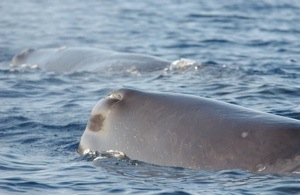Marine Mammal Species Description
Sperm Whale
Physeter macrocephalus

Photo credit: Wayne Hoggard NOAA/NMFS/SEFSC
Classification
Order: Cetacea
Family: Physeteridae
Alternate Common Names:
Status: ESA Endangered/ MMPA Depleted
Description:
Length: males: 36-60 ft (11-18.3 m); females: 27-41 ft (8.3-12.5 m)
Weight: males: 24,250-125,660 lbs (11,000-57,000 kg); females: 14,990-52,910 lbs (6,800-24,000 kg)
Sperm whales are sexually dimorphic, with adult males being much larger than adult females. Where a dorsal fin normally occurs (about two-thirds of the way back on the body) there is a hump. They have a broad, triangular-shaped fluke. On their flukes are various notches, scratches and scars that observers can use to identify individual whales. These whales have one blowhole that is located close to the back of the head and is slightly offset to the left of the body?s midline. Sperm whales have a very large head, which makes up about 30% of its total body length that protrudes beyond their underslung lower jaw. They also have 18-26 pairs of teeth on their lower jaw and up to 10 pairs of small teeth in the upper jaw. The teeth in the upper jaw are usually covered from the gums and not visible. They tend to have scars and scratches on their heads. Overall, sperm whales are dark gray, black, or bluish with some white on the belly and around the mouth.
Habitat:
Sperm whales occur in deep waters of the open sea, from the continental slope seaward, worldwide. Male sperm whales occur in a wide variety of depths as long as areas have abundant food sources. Females tend to stay in deep waters (>3,280 ft / >1000 m). Typically, sperm whales have two types of schools. One, termed a breeding school, has females and pre-breeding males, usually less than 21 years old. These schools are typically made up of closely related females and their young. The other, termed a bachelor school, is made up of sexually mature males and older, but still pre-breeding aged males (older than 21 years). Breeding schools can contain 1-5 adult males during the breeding season (January to August) and 4-150 individuals total. Bachelor schools typically have up to 50 individuals. Females and breeding schools tend to be in the warmer areas of their range (in waters above 59° F (15° C). Typically, only males are seen in the polar extremes. Schools of sperm whales are larger in size in areas with high concentrations of food.
Feeding:
Sperm whales eat mostly squid and octopi. They will occasionally eat other items like fish. They spend around 75% of each day foraging. Even though they have teeth, they suck food into their mouth and swallow them whole. Sperm whales can dive for 60-90 minutes at a time and to depths of over 7,218 ft (2,200 m). However, most dives are for less than 30 minutes and less than 1,640 ft (500 m) depth. Calves typically do not to make deep foraging dives and will remain near the surface moving between members of the school as different females dive. The females of a school make their foraging dives at different times so that a number of adult females are always near the surface to tend to calves as their mothers make their deep foraging dives.
Reproduction:
Female sperm whales reach sexual maturity at 7-13 years old and males reach maturity at 18-21 years old. Females give birth once about every five years. Peak breeding season is believed to be from March and June in the Northern Hemisphere and from October and December in the Southern Hemisphere. The gestation period lasts 14-15 months after which females give birth to a single calf. Occasionally, two or three young are born. Females nurse each calf for two or more years.
Other:
The life span of sperm whales is approximately 60-70 years. Sperm whales were once hunted widely for their oil and spermaceti. By 1880, the whaling industry reduced the worldwide population of sperm whales by 70%. Sperm whales typically travel at around 3.5 m/h (4 km/h) and can travel up to 56 miles (90 km) in a day in search of food.
Distribution / Range:
Sperm whales occur worldwide, except in the very extreme polar regions. Off the east coast of the United States, they are most commonly seen along the continental shelf where there is a lot of squid.
Similar species:
Notes:
References:
American Cetacean Society. 2004. American Cetacean Society Fact Sheet. http://www.acsonline.org/factpack/spermwhl.htm. Accessed January 2012.
Culik, B. 2010. Odontocetes. The toothed whales: "Physeter macrocephalus". UNEP/CMS Secretariat, Bonn, Germany. http://www.cms.int/reports/small_cetaceans/index.htm. Accessed January 2012.
Potter, C.W. and B. Birchler. 1999. Sperm whale, Physeter macrocephalus. In The Smithsonian Book of North American Mammals. Wilson, D.E. and S. Ruff, eds., 299-301. Smithsonian Institution in association with the American Society of Mammologists, Washington DC.
Taylor, B.L., Baird, R., Barlow, J., Dawson, S.M., Ford, J., Mead, J.G., Notarbartolo di Sciara, G., Wade, P. & Pitman, R.L. 2008. Physeter macrocephalus. In: IUCN 2011. IUCN Red List of Threatened Species. Version 2011.2. www.iucnredlist.org. Downloaded on 09 January 2012.
Whitehead, H. 2002. Estimates of the current global population size and historical trajectory for sperm whales. Marine Ecology Progress Series 242: 295-304.
Whitehead, H. 2009. Sperm Whale - Physeter macrocephalus. In: Encyclopedia of Marine Mammals 2nd Ed. Perrin W.F., B. Würsig, and J.G.M. Thewissen, eds. Academic Press, New York, pp. 1091-1097.

 Marine Mammals of Georgia
Marine Mammals of Georgia